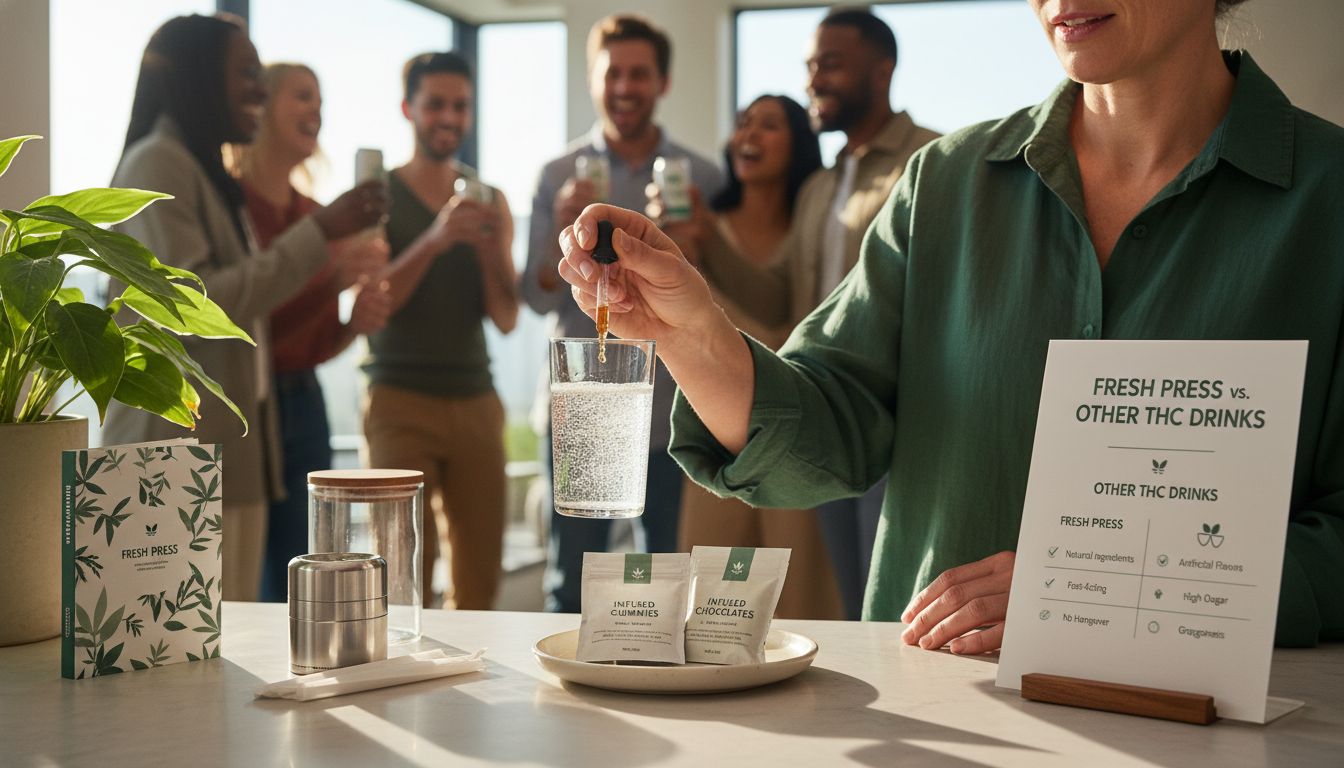More than 35 states now offer legal access to cannabis products, yet many consumers still feel confused about the real difference between infused and non-infused options. With so many choices on dispensary shelves, understanding what actually goes into each product matters more than ever. This guide brings clarity to these terms, helping you make confident decisions and find the best fit for your wellness or recreational goals.
Table of Contents
- Defining Infused And Non-Infused Products
- Types Of Infused And Non-Infused Cannabis Goods
- Key Benefits And Effects Compared
- Legal Status And Compliance In The U.S.
- Choosing The Right Product For Your Needs
Key Takeaways
| Point | Details |
|---|---|
| Distinction Between Infused and Non-Infused Products | Infused products contain integrated cannabis compounds, providing controlled dosages and varied consumption methods, while non-infused products do not include cannabinoids. |
| Diverse Product Offerings | Infused goods include multiple categories like edibles, topicals, and tinctures, whereas non-infused items encompass traditional tools and accessories. |
| Impact of Consumption Method | The method of consumption affects onset time and overall experience; infused products offer slower effects while non-infused are absorbed quickly. |
| Navigating Legal Landscape | Understanding the regulatory environment is crucial, as state and federal laws vary significantly regarding cannabis products and compliance. |
Defining Infused and Non-Infused Products
Understanding the nuanced world of cannabis and hemp products begins with distinguishing between infused and non-infused offerings. According to Kiwa, these categories represent fundamentally different approaches to incorporating cannabis compounds into consumer goods.
Infused products are characterized by the deliberate integration of cannabis or hemp-derived compounds directly into the product’s composition. This means active ingredients like THC, CBD, or other cannabinoids are chemically blended into the base substance, creating a comprehensive and uniform experience. Law Insider provides clarity, defining infused products across multiple consumption categories:
- Edible Infusions: Beverages, foods, and consumables with integrated cannabis compounds
- Topical Infusions: Lotions, creams, and skincare items with embedded cannabinoids
- Transdermal Products: Patches and applications designed for controlled substance absorption
- Tincture Infusions: Liquid extracts with concentrated cannabis elements
Non-infused products, by contrast, represent traditional goods that do not inherently contain cannabis compounds. These items might be used alongside or in conjunction with cannabis products but do not have active ingredients chemically integrated into their structure. The key distinction lies in the intentional incorporation of cannabinoids.
For enthusiasts exploring the vibrant world of cannabis wellness, understanding these definitions becomes crucial. Whether you’re seeking a guide on hemp infusion or curious about emerging beverage trends, recognizing the fundamental differences between infused and non-infused products empowers more informed consumption choices.
Types of Infused and Non-Infused Cannabis Goods
The world of cannabis consumption offers a rich tapestry of product types, ranging from traditional non-infused goods to innovative infused offerings that transform user experiences. According to Journal of Cannabis Research, cannabis-infused edibles alone represent a diverse landscape spanning multiple categories.
Infused Cannabis Goods encompass several exciting product types:
-
Edible Infusions:
- Baked Goods: Cookies, brownies, pastries
- Beverages: Sparkling waters, teas, energy drinks
- Candies: Gummies, hard candies, chocolates
- Frozen Treats: Ice creams, popsicles
- Preserves: Honey, sauces, spreads
Non-Infused Cannabis Goods represent more traditional consumption methods that do not inherently contain active cannabinoids. These might include:
- Rolling papers
- Pipes and smoking accessories
- Storage containers
- Grinders
- Hemp-based clothing and textiles
Research from Frontiers in Pharmacology highlights the nuanced differences in consumption experiences across various product types. The method of delivery significantly impacts onset time, duration, and overall user experience.
For cannabis enthusiasts eager to explore the evolving landscape of consumption, understanding the types of cannabis products becomes crucial in making informed wellness choices.
![]() Each product type offers unique benefits, catering to diverse preferences and individual wellness journeys.
Each product type offers unique benefits, catering to diverse preferences and individual wellness journeys.

Key Benefits and Effects Compared
Comparing the benefits and effects of infused and non-infused cannabis products reveals a fascinating landscape of consumption experiences and potential wellness outcomes. PubMed research highlights critical differences in how these products interact with the human body, particularly emphasizing the unique physiological responses triggered by different consumption methods.
Infused Product Effects:
- Controlled Dosage: Precise cannabinoid concentration
- Extended Duration: Slower metabolization
- Gradual Onset: Less immediate impact
- Versatile Consumption: Multiple intake methods
Non-Infused Product Characteristics:
- Immediate Effects: Faster absorption
- Short-Term Impact: Quicker metabolization
- Traditional Consumption: Smoking, vaping methods
- Variable Potency: Less predictable dosing
Research from Academic Journals underscores the complexity of studying high-concentration THC products, noting significant methodological challenges in comprehensively understanding their long-term impacts. The variability between infused and non-infused products demands nuanced, individualized approaches to consumption.
For those curious about navigating this complex landscape, understanding Delta-8’s role in wellness can provide additional context for making informed choices about cannabis consumption methods and potential health benefits.
Legal Status and Compliance in the U.S.
Navigating the complex legal landscape of cannabis products requires a nuanced understanding of federal and state regulations. According to National Cannabis Industry Association, the regulatory framework for cannabis-derived compounds involves intricate considerations regarding product classification, functional purposes, and compliance standards.
Key Legal Considerations:
- Federal vs State Regulations: Significant variations exist
- Hemp-Derived Products: Often more legally permissive
- THC Concentration Limits: Typically below 0.3% for legal status
- Product Type Distinctions: Different rules for infused vs non-infused goods
Compliance Challenges:
- Evolving legislative landscape
- Varying state-level restrictions
- Ongoing FDA regulatory discussions
- Complex product classification processes
Research from Food and Drug Law Institute highlights the ongoing development of cannabis edibles as potential botanical drugs, emphasizing the dynamic nature of regulatory frameworks. The competitive landscape continues to shift, with increasing focus on standardization and consumer safety.
For cannabis enthusiasts seeking to understand the intricate world of legal cannabis products, understanding the difference between CBG and CBD can provide valuable insights into navigating these complex regulatory environments.
Choosing the Right Product for Your Needs
Selecting the ideal cannabis product requires a thoughtful approach that considers individual wellness goals, consumption preferences, and personal comfort levels. Cambridge University Research reveals fascinating insights into consumer decision-making processes when exploring cannabis and hemp-derived products.
Key Selection Criteria:
-
Personal Wellness Goals
- Stress relief
- Sleep enhancement
- Pain management
- Recreational enjoyment
Product Selection Factors:
- Desired onset speed
- Duration of effects
- Cannabinoid concentration
- Consumption method comfort
- Potential side effects
- Legal compliance
Research from TCI Journal emphasizes the importance of understanding personal preferences and body responses when choosing cannabis-infused products. Each individual’s endocannabinoid system responds uniquely, making personalization crucial.
For those seeking deeper understanding of their options, understanding CBG-infused drinks for wellness can provide valuable context for making informed, personalized choices in your cannabis journey.
Discover the Perfect Balance Between Infused and Non-Infused Products for Your Wellness Journey
Choosing between infused and non-infused cannabis products can feel overwhelming without clear guidance. This guide helps you understand key concepts like controlled dosage, onset speed, and consumption methods while addressing the challenge of finding products that match your personal wellness goals and lifestyle preferences. Whether you seek extended relief or quick effects, knowing the difference ensures a confident selection.
Explore our expertly crafted selection of Drink Enhancers and THC Drink Bundles and SHAKE to experience premium hemp-derived infusions designed to elevate your routine. Each product is made with care to provide consistent dosing and a smooth experience, helping you enjoy the benefits the article highlights.

Ready to embrace a smarter way to enjoy cannabis wellness? Visit 23state.com now to browse our full collection and take advantage of special offers like free shipping. Your ideal infused product awaits to enhance your daily ritual.
Frequently Asked Questions
What are infused cannabis products?
Infused cannabis products are those that intentionally incorporate cannabis or hemp-derived compounds, such as THC or CBD, directly into their composition. These products include edibles, topicals, tinctures, and transdermal items with a uniform concentration of cannabinoids.
How do infused and non-infused products differ in terms of effects?
Infused products typically offer controlled dosages, extended duration, and gradual onset effects due to the slow metabolization of cannabinoids. Non-infused products, on the other hand, usually provide immediate effects with quicker absorption, but with less predictability regarding potency and duration.
What types of infused products are available?
Infused products include a variety of options such as edible infusions like baked goods, beverages, candies, frozen treats, and preserves. Additionally, there are topical infusions such as lotions and tinctures that deliver cannabinoids through different methods.
What should I consider when choosing between infused and non-infused products?
When selecting a product, consider your personal wellness goals (e.g., stress relief, pain management), desired onset speed of effects, cannabinoid concentration, consumption method, and any potential side effects. Each individual’s experience may vary, so personalization is key.

